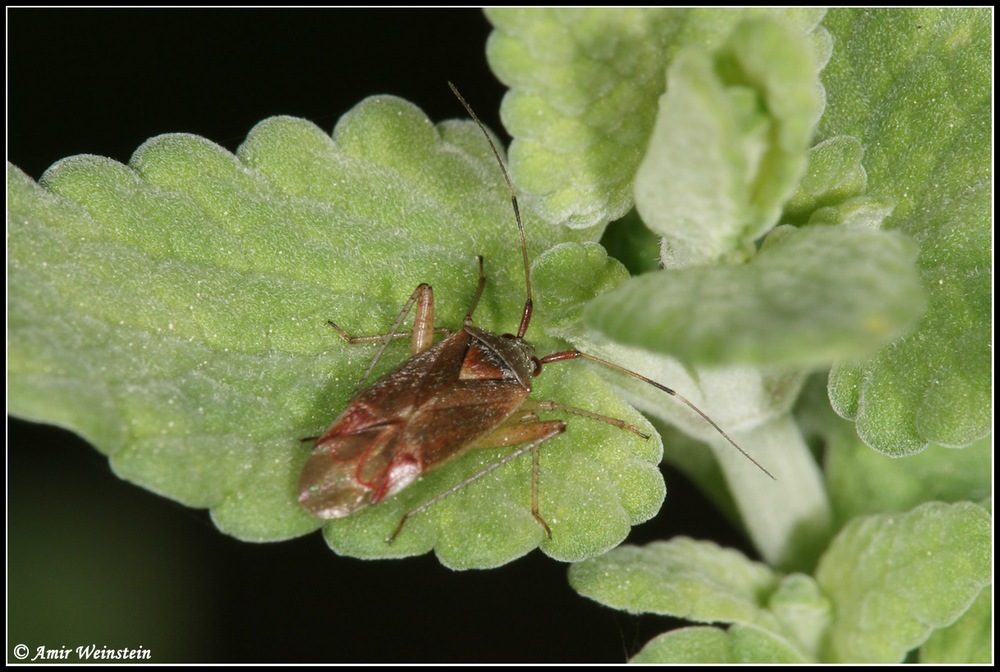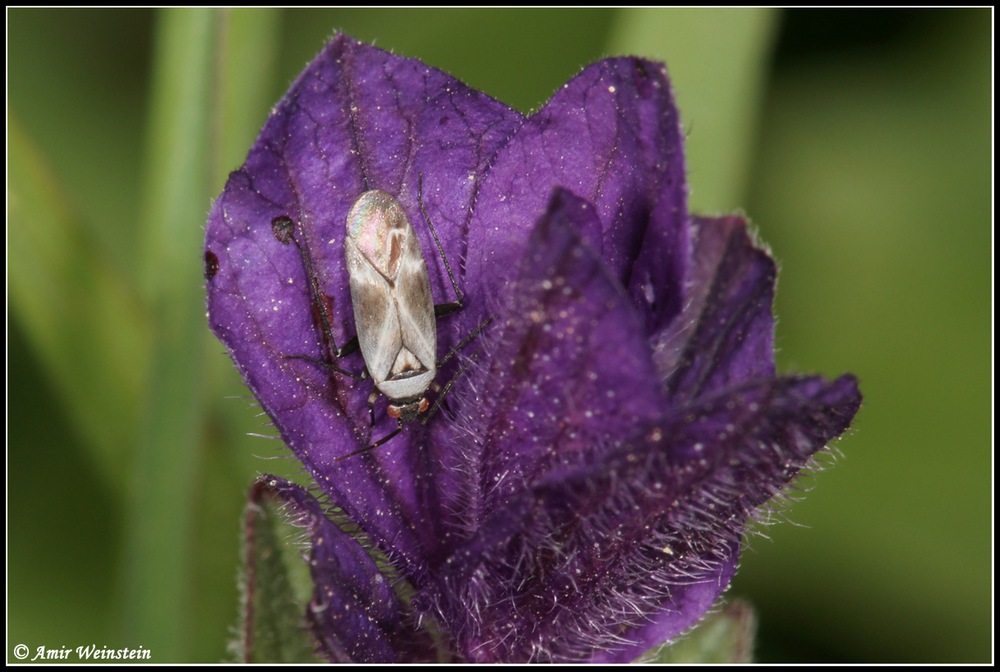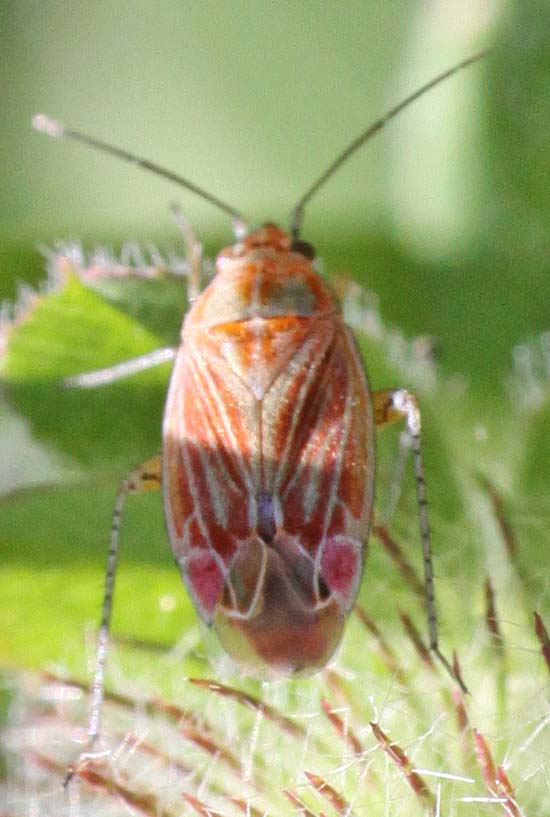| Autore |
 Discussione Discussione  |
|
|
Amir
Utente Senior
   

Città: Tel-Aviv
Regione: Israel

785 Messaggi
Tutti i Forum |
|
|
Amir
Utente Senior
   

Città: Tel-Aviv
Regione: Israel

785 Messaggi
Tutti i Forum |
 Inserito il - 13 aprile 2009 : 21:57:17 Inserito il - 13 aprile 2009 : 21:57:17


|
Set 2
Immagine:

184,33 KB
my albums:
Link
My insects blog (in Hebrew)
Link |
 |
|
|
Amir
Utente Senior
   

Città: Tel-Aviv
Regione: Israel

785 Messaggi
Tutti i Forum |
 Inserito il - 13 aprile 2009 : 21:58:02 Inserito il - 13 aprile 2009 : 21:58:02


Classe: Hexapoda Ordine: Hemiptera Heteroptera Famiglia: Miridae Genere: Macrotylus Specie:Macrotylus syriacus (cfr.)
|
Set 3
Immagine:

159,33 KB
my albums:
Link
My insects blog (in Hebrew)
Link |
Modificato da - vladim in data 19 dicembre 2015 13:12:49 |
 |
|
|
Paris
Moderatore
    

Città: Sondrio
Prov.: Sondrio
Regione: Lombardia

5748 Messaggi
Flora e Fauna |
 Inserito il - 18 aprile 2009 : 00:23:46 Inserito il - 18 aprile 2009 : 00:23:46


|
Come sempre Amir ci stupisce per la bellezza delle sue immagini.
Constato che nessuno ha ancora azzardato un nome per nessuno dei tre miridi di questa discussione. Onestamente le determinazioni non sono facili neppure per me, ma vediamo cosa possiamo fare.
1) Calocoris roseomaculatus angularis (Fieber, 1864). Si tratta della sottospecie mediorientale. Quella nominale è presente nel Mediterraneo occidentale e in Europa.
2) Megacoelum cfr. brevirostre Reuter, 1879. Già segnalata in Israele, si distingue da M.pellucens (vedi Tassonomia) per la colorazione più rossiccia e le cellule della membrana bordate di rosso. Manca tuttavia la conferma per quanto riguarda il rapporto tra larghezza oculare e spazio inter-oculare che, in questo caso, non è misurabile.
3) per ora non mi pronuncio.
-----------
"La vita è l'arte dell'incontro" (Vinicius De Moraes) |
 |
|
|
StagBeetle
Moderatore
    

Città: Ancona
Prov.: Ancona
Regione: Marche

6321 Messaggi
Tutti i Forum |
 Inserito il - 18 aprile 2009 : 09:22:56 Inserito il - 18 aprile 2009 : 09:22:56


|
Io ci provo ad aiutare...
Il primo mi sembra assomigli ad un Calocoris roseomaculatus.
Il secondo è quello che mi lascia più dubbi: Pinalitus?????
Il terzo potrebbe esere un Macrotylus...
Ciao
Giacomo |
 |
|
|
Paris
Moderatore
    

Città: Sondrio
Prov.: Sondrio
Regione: Lombardia

5748 Messaggi
Flora e Fauna |
 Inserito il - 18 aprile 2009 : 10:34:52 Inserito il - 18 aprile 2009 : 10:34:52


|
1) Su questa specie dovremmo essere daccordo.
2) Attendo un vostro parere, almeno sul fatto che sia un Megacoelum sp. (spine accentuate sulle tibie posteriori).
3) Inizialmente ero orientato anch'io su Macrotylus, ma in seguito mi è venuto qualche dubbio. Ricontrollando (Wagner 1973) sono propenso per Macrotylus syriacus Wagner, 1963, una specie sin'ora nota della Siria (Antelebanon) la cui presenza in Israele non è da escludere. La pianta ospite è Salvia acetabulosa. (Linnaeus: Salvia Orientalis frutescens serratis foliis, calice hirsuto flore violaceo, stamine longissme )
-----------
"La vita è l'arte dell'incontro" (Vinicius De Moraes) |
 |
|
|
Amir
Utente Senior
   

Città: Tel-Aviv
Regione: Israel

785 Messaggi
Tutti i Forum |
 Inserito il - 19 aprile 2009 : 08:14:57 Inserito il - 19 aprile 2009 : 08:14:57


|
Grazie Paris
For all the ID's efforts
BTW, the Salvia is Salvia viridis L.
Link
Here a Calocoris cf nemoralis from Tel-Aviv
Immagine:

174,62 KB
my albums:
Link
My insects blog (in Hebrew)
Link |
 |
|
|
Assaf
Utente V.I.P.
  
Città: Haifa

343 Messaggi
Flora e Fauna |
 Inserito il - 19 aprile 2009 : 09:03:11 Inserito il - 19 aprile 2009 : 09:03:11


Classe: Hexapoda Ordine: Hemiptera Heteroptera Famiglia: Miridae Genere: Pachyxyphus Specie:Pachyxyphus lineellus
|
It is hard to identify miridae from a photo but I'll try to guess....
1. Maybe Calocoris cf. roseomaculatus
2. Maybe Closterotomus cf. annulus.
3. Never saw it but doesnt Megacoelum brevirostre should be bright yellow-brown with pale yellowish legs?
Here is another miridae that escaped before I looked closer. Anyone know it?
Immagine:

72,36 KB |
Modificato da - Paris in data 27 aprile 2009 15:06:01 |
 |
|
|
Paris
Moderatore
    

Città: Sondrio
Prov.: Sondrio
Regione: Lombardia

5748 Messaggi
Flora e Fauna |
 Inserito il - 21 aprile 2009 : 00:52:03 Inserito il - 21 aprile 2009 : 00:52:03


|
Dear Assaf, for the Amir's 2nd photoset you suggest C.annulus, but this species has smaller antennal articles!! look here: Link . .
Megacoelum has very long antennae  : I'm not sure about the right name of this species 'cause it's very difficult to study mirids in photos, as you said. : I'm not sure about the right name of this species 'cause it's very difficult to study mirids in photos, as you said.
Last photo seems to be Pachyxyphus lineellus (Mulsant, 1852)
-----------
"La vita è l'arte dell'incontro" (Vinicius De Moraes) |
 |
|
|
Assaf
Utente V.I.P.
  
Città: Haifa

343 Messaggi
Flora e Fauna |
 Inserito il - 21 aprile 2009 : 09:18:05 Inserito il - 21 aprile 2009 : 09:18:05


|
Dear paris,
Photos can sometime confuse, I'm not sure the anntena are so long It dependent on the photo view angle see for example here Link first photo show C.annulus with longer antenna. first photo show C.annulus with longer antenna.
As far as I can see from Amir photo it had long dorsal white hairs when Megacoelum usally have bare or only short hairs. The only species with long dorsal hairs according to Linnavuori 1974 are M. beckeri Fb., M. quercicola Lv., M. pulchricorne Rt. and M. angustum Wgn. which of them only M.pulchricorne has bright hairs.
I think I already seen this miridae before I'll search for it and post new info if I have. |
 |
|
|
Amir
Utente Senior
   

Città: Tel-Aviv
Regione: Israel

785 Messaggi
Tutti i Forum |
 Inserito il - 21 aprile 2009 : 19:06:18 Inserito il - 21 aprile 2009 : 19:06:18


|
Ciao
add a crop of the second photo
Immagine:

287,83 KB
my albums:
Link
My insects blog (in Hebrew)
Link |
 |
|
|
Paris
Moderatore
    

Città: Sondrio
Prov.: Sondrio
Regione: Lombardia

5748 Messaggi
Flora e Fauna |
 Inserito il - 27 aprile 2009 : 15:01:26 Inserito il - 27 aprile 2009 : 15:01:26


|
Wagner, about Megacoelum says: "oberseite kahl", so I think that Assaf is right. But I'm doubtful, 'cause this specimen has strong thorns also on aterior legs. I' shall see again Calocoris/Closterotomus group...
-----------
"La vita è l'arte dell'incontro" (Vinicius De Moraes) |
 |
|
| |
 Discussione Discussione  |
|

 Forum
|
Registrati
|
Msg attivi
|
Msg Recenti
|
Msg Pvt
|
Utenti
|
Galleria |
Map |
Forum
|
Registrati
|
Msg attivi
|
Msg Recenti
|
Msg Pvt
|
Utenti
|
Galleria |
Map |